Hierarchical Clustering
Contents
import numpy as np
import scipy as sp
import matplotlib.pyplot as plt
import pandas as pd
import sklearn.datasets as sk_data
from sklearn.cluster import KMeans
#import matplotlib as mpl
import seaborn as sns
%matplotlib inline
Hierarchical Clustering#
Today we will look at a fairly different approach to clustering.
So far, we have been thinking of clustering as finding a partition of our dataset.
That is, a set of nonoverlapping clusters, in which each data item is in one cluster.
However, in many cases, the notion of a strict partition is not as useful.
How Many Clusters?#
How many clusters would you say there are here?
X_rand, y_rand = sk_data.make_blobs(n_samples=[100, 100, 250, 70, 75, 80], centers = [[1, 2], [1.5, 1], [3, 2], [1.75, 3.25], [2, 4], [2.25, 3.25]], n_features = 2,
center_box = (-10.0, 10.0), cluster_std = [.2, .2, .3, .1, .15, .15], random_state = 0)
df_rand = pd.DataFrame(np.column_stack([X_rand[:, 0], X_rand[:, 1], y_rand]), columns = ['X', 'Y', 'label'])
df_rand = df_rand.astype({'label': 'int'})
df_rand['label2'] = [{0: 0, 1: 1, 2: 2, 3: 3, 4: 3, 5: 3}[x] for x in df_rand['label']]
df_rand['label3'] = [{0: 0, 1: 0, 2: 1, 3: 2, 4: 2, 5: 2}[x] for x in df_rand['label']]
# kmeans = KMeans(init = 'k-means++', n_clusters = 3, n_init = 100)
# df_rand['label'] = kmeans.fit_predict(df_rand[['X', 'Y']])
df_rand.plot('X', 'Y', kind = 'scatter',
colorbar = False, figsize = (6, 6))
plt.axis('square')
plt.axis('off');

Three clusters?
df_rand.plot('X', 'Y', kind = 'scatter', c = 'label3', colormap='viridis',
colorbar = False, figsize = (6, 6))
plt.axis('square')
plt.axis('off');
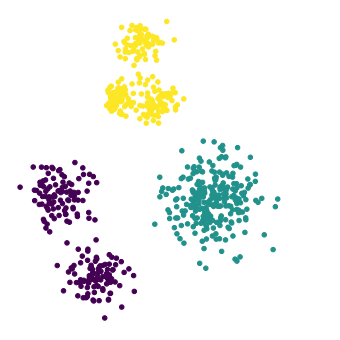
Four clusters?
df_rand.plot('X', 'Y', kind = 'scatter', c = 'label2', colormap='viridis',
colorbar = False, figsize = (6, 6))
plt.axis('square')
plt.axis('off');

Six clusters?
df_rand.plot('X', 'Y', kind = 'scatter', c = 'label', colormap='viridis',
colorbar = False, figsize = (6, 6))
plt.axis('square')
plt.axis('off');
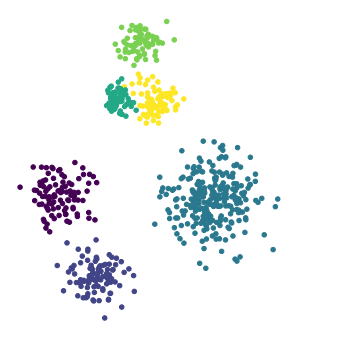
This dataset shows clustering on multiple scales.
To fully capture the structure in this dataset, two things are needed:
Capturing the differing clusters depending on the scale
Capturing the containment relations – which clusters lie within other clusters
These observations motivate the notion of hierarchical clustering.
In hierarchical clustering, we move away from the partition notion of \(k\)-means,
and instead capture a more complex arrangement that includes containment of one cluster within another.
Hierarchical Clustering#
A hierarchical clustering produces a set of nested clusters organized into a tree.
A hierarchical clustering is visualized using a dendrogram
A tree-like diagram that records the containment relations among clusters.
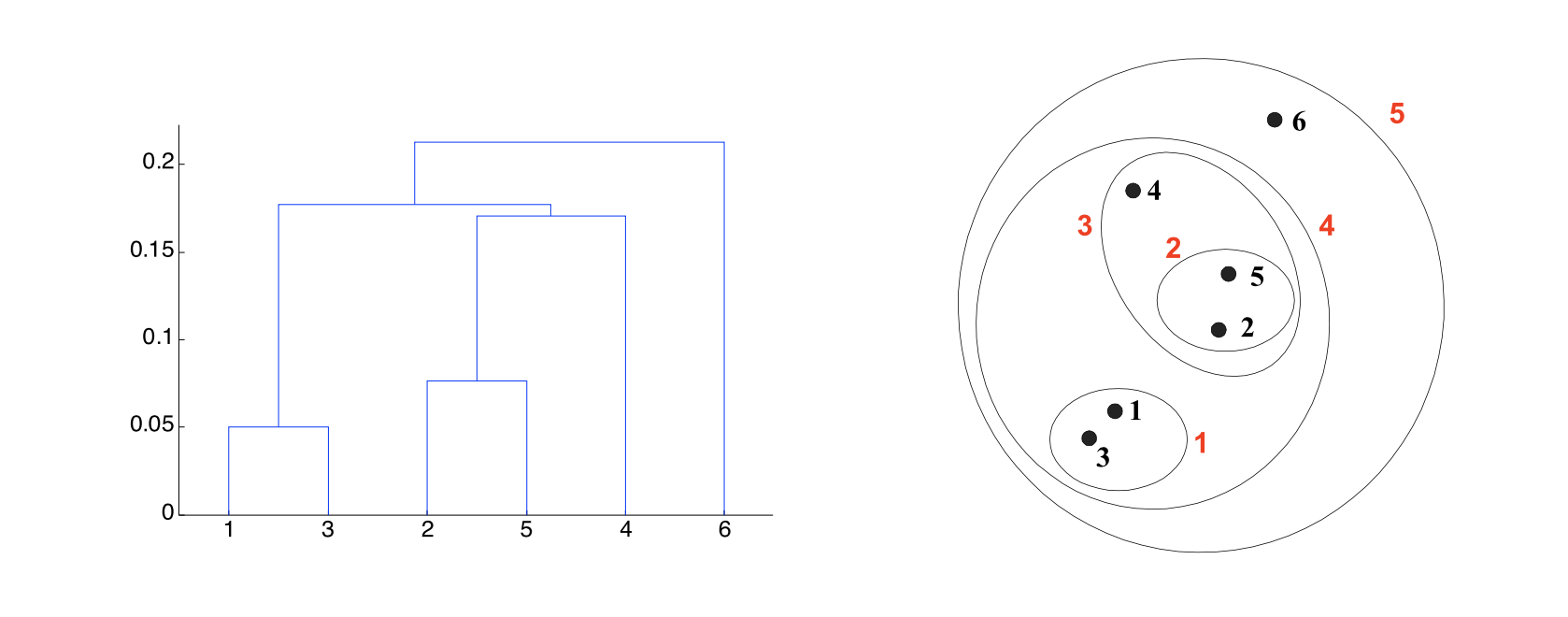
Strengths of Hierarchical Clustering#
Hierarchical clustering has a number of advantages:
First, a hierarchical clustering encodes many different clusterings. That is, it does not itself decide on the correct number of clusters.
A clustering is obtained by “cutting” the dendrogram at some level.
This means that you can make this crucial decision yourself, by inspecting the dendrogram.
Put another way, you can obtain any desired number of clusters.

The second advantage is that the dendrogram may itself correspond to a meaningful structure, for example, a taxonomy.
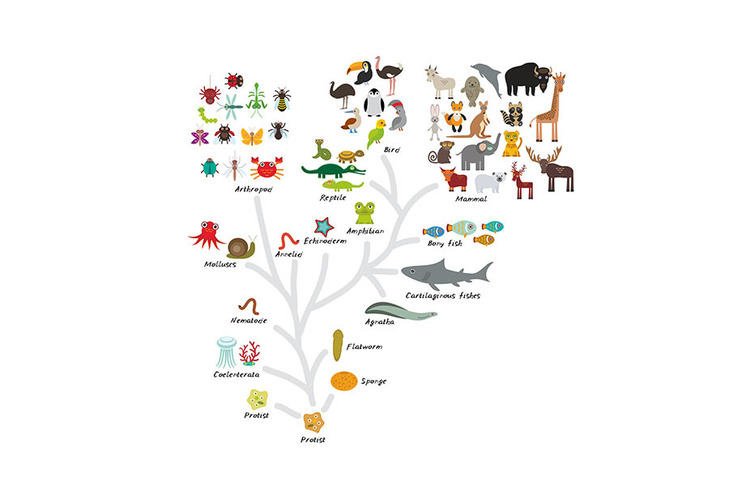
The third advantage is that many hierarchical clustering methods can be performed using either similarity (proximity) or dissimilarity (distance) metrics.
This can be very helpful!
(Note that techniques like \(k\)-means cannot be used with unmodified similarity metrics.)
Compared to \(k\)-means#
Another aspect of hierachical clustering is that it can handle certain cases better than \(k\)-means.
Because of the nature of the \(k\)-means algorithm, \(k\)-means tends to produce:
Roughly spherical clusters
Clusters of approximately equal size
Non-overlapping clusters
In many real-world situations, clusters may not be round, they may be of unequal size, and they may overlap.
Hence we would like clustering algorithms that can work in those cases also.
Hierarchical Clustering Algorithms#
There are two main approaches to hierarchical clustering: “bottom-up” and “top-down.”
Agglomerative Clustering (“bottom-up”):
Start by defining each point as its own cluster
At each successive step, merge the two clusters that are closest to each other
Repeat until only one cluster is left.
Divisive Clustering (“top-down”):
Start with one, all-inclusive cluster
At each step, find the cluster split that creates the largest distance between resulting clusters
Repeat until each point is in its own cluster.
Agglomerative techniques are by far the more common.
The key to both of these methods is defining the distance between two clusters.
Different definitions for the inter-cluster distance yield different clusterings.
To illustrate the impact of the choice of cluster distances, we’ll focus on agglomerative clustering.
Defining Cluster Proximity#
Given two clusters, how do we define the distance between them?
Here are three natural ways to do it:
Single-Linkage: the distance between two clusters is the distance between the closest two points that are in different clusters.
Complete-Linkage: the distance between two clusters is the distance between the farthest two points that are in different clusters.
Average-Linkage: the distance between two clusters is the average distance between all pairs of points from different clusters.

Notice that it is easy to express the definitions above in terms of similarity instead of distance.
Here is a set of 6 points that we will cluster to show differences between distance metrics.
pt_x = [0.4, 0.22, 0.35, 0.26, 0.08, 0.45]
pt_y = [0.53, 0.38, 0.32, 0.19, 0.41, 0.30]
plt.plot(pt_x, pt_y, 'o', markersize = 10, color = 'k')
plt.ylim([.15, .60])
plt.xlim([0.05, 0.70])
for i in range(6):
plt.annotate(f'{i}', (pt_x[i]+0.02, pt_y[i]-0.01), fontsize = 12)
plt.axis('off')
plt.savefig('figs/L08-basic-pointset.png');

X = np.array([pt_x, pt_y]).T
from scipy.spatial import distance_matrix
labels = ['p0', 'p1', 'p2', 'p3', 'p4', 'p5']
D = pd.DataFrame(distance_matrix(X, X), index = labels, columns = labels)
D.style.format('{:.2f}')
| p0 | p1 | p2 | p3 | p4 | p5 | |
|---|---|---|---|---|---|---|
| p0 | 0.00 | 0.23 | 0.22 | 0.37 | 0.34 | 0.24 |
| p1 | 0.23 | 0.00 | 0.14 | 0.19 | 0.14 | 0.24 |
| p2 | 0.22 | 0.14 | 0.00 | 0.16 | 0.28 | 0.10 |
| p3 | 0.37 | 0.19 | 0.16 | 0.00 | 0.28 | 0.22 |
| p4 | 0.34 | 0.14 | 0.28 | 0.28 | 0.00 | 0.39 |
| p5 | 0.24 | 0.24 | 0.10 | 0.22 | 0.39 | 0.00 |
Single-Linkage Clustering#

import scipy.cluster
import scipy.cluster.hierarchy as hierarchy
Z = hierarchy.linkage(X, method='single')
hierarchy.dendrogram(Z);
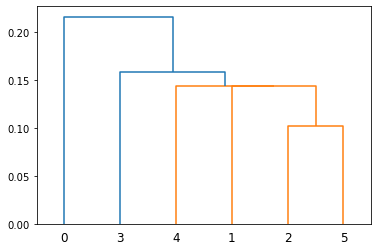
Advantages:
Single-linkage clustering can handle non-elliptical shapes.
In fact it can produce long, elongated clusters:
X_moon_05, y_moon_05 = sk_data.make_moons(random_state = 0, noise = 0.05)
Z = hierarchy.linkage(X_moon_05, method='single')
labels = hierarchy.fcluster(Z, 2, criterion = 'maxclust')
plt.scatter(X_moon_05[:,0], X_moon_05[:,1], c = [['b','g'][i-1] for i in labels])
plt.title('Single-Linkage Can Find Irregularly Shaped Clusters')
plt.axis('off');

X_rand_lo, y_rand_lo = sk_data.make_blobs(n_samples=[20, 200], centers = [[1, 1], [3, 1]], n_features = 2,
center_box = (-10.0, 10.0), cluster_std = [.1, .5], random_state = 0)
Z = hierarchy.linkage(X_rand_lo, method='single')
labels = hierarchy.fcluster(Z, 2, criterion = 'maxclust')
plt.scatter(X_rand_lo[:,0], X_rand_lo[:,1], c = [['b','g'][i-1] for i in labels])
plt.title('Single-Linkage Can Find Different-Sized Clusters')
plt.axis('off');
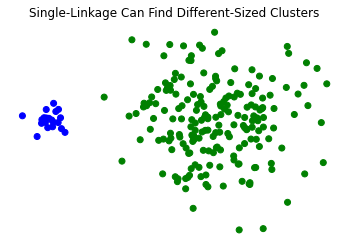
Disadvantages:
Single-linkage clustering can be sensitive to noise and outliers.
X_moon_10, y_moon_10 = sk_data.make_moons(random_state = 0, noise = 0.1)
Z = hierarchy.linkage(X_moon_10, method='single')
labels = hierarchy.fcluster(Z, 2, criterion = 'maxclust')
plt.scatter(X_moon_10[:,0], X_moon_10[:,1], c = [['b','g'][i-1] for i in labels])
plt.title('Single-Linkage Clustering Changes Drastically on Slightly More Noisy Data')
plt.axis('off');
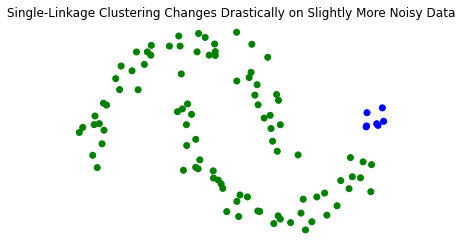
X_rand_hi, y_rand_hi = sk_data.make_blobs(n_samples=[20, 200], centers = [[1, 1], [3, 1]], n_features = 2,
center_box = (-10.0, 10.0), cluster_std = [.15, .6], random_state = 0)
Z = hierarchy.linkage(X_rand_hi, method='single')
labels = hierarchy.fcluster(Z, 2, criterion = 'maxclust')
plt.title('Single-Linkage Clustering Changes Drastically on Slightly More Noisy Data')
plt.scatter(X_rand_hi[:,0], X_rand_hi[:,1], c = [['b','g'][i-1] for i in labels])
plt.axis('off');
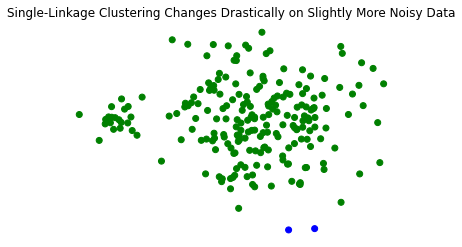
Complete-Linkage Clustering#
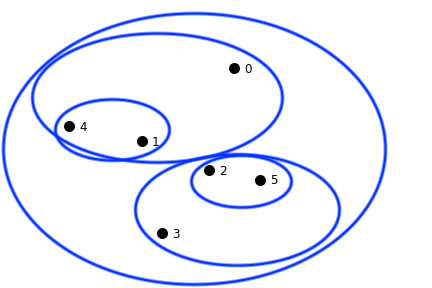
Z = hierarchy.linkage(X, method='complete')
hierarchy.dendrogram(Z);

Advantages:
Produces more-balanced clusters – more-equal diameters
X_moon_05, y_moon_05 = sk_data.make_moons(random_state = 0, noise = 0.05)
Z = hierarchy.linkage(X_moon_05, method='complete')
labels = hierarchy.fcluster(Z, 2, criterion = 'maxclust')
plt.scatter(X_moon_05[:,0], X_moon_05[:,1], c = [['b','g'][i-1] for i in labels])
plt.title('Complete-Linkage Seeks Globular Clusters of Similar Size')
plt.axis('off');

Z = hierarchy.linkage(X_rand_hi, method='complete')
labels = hierarchy.fcluster(Z, 2, criterion = 'maxclust')
plt.scatter(X_rand_hi[:,0], X_rand_hi[:,1], c = [['b','g'][i-1] for i in labels])
plt.title('Complete-Linkage Seeks Globular Clusters of Similar Size')
plt.axis('off');

Less susceptible to noise:
Z = hierarchy.linkage(X_moon_10, method='complete')
labels = hierarchy.fcluster(Z, 2, criterion = 'maxclust')
plt.scatter(X_moon_10[:,0], X_moon_10[:,1], c = [['b','g'][i-1] for i in labels])
plt.title('Complete-Linkage Clustering of Noisy Data similar to Less Noisy')
plt.axis('off');
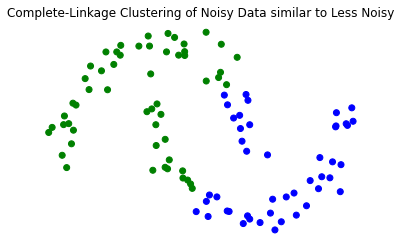
Average-Linkage Clustering#

Z = hierarchy.linkage(X, method='average')
hierarchy.dendrogram(Z);

Average-Linkage clustering is in some sense a compromise between Single-linkage and Complete-linkage clustering.
Strengths:
Less susceptible to noise and outliers
Limitations:
Biased toward elliptical clusters
Z = hierarchy.linkage(X_moon_10, method='average')
labels = hierarchy.fcluster(Z, 2, criterion = 'maxclust')
plt.scatter(X_moon_10[:,0], X_moon_10[:,1], c = [['b','g'][i-1] for i in labels])
plt.title('Average-Linkage Similar to Complete - Globular Clusters')
plt.axis('off');
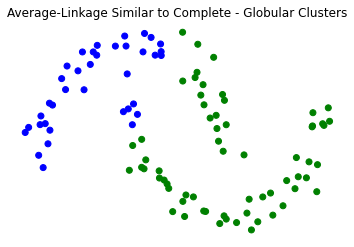
Z = hierarchy.linkage(X_rand_hi, method='average')
labels = hierarchy.fcluster(Z, 2, criterion = 'maxclust')
plt.scatter(X_rand_hi[:,0], X_rand_hi[:,1], c = [['b','g'][i-1] for i in labels])
plt.title('Average-Linkage More resistant to noise than Single-Linkage')
plt.axis('off');

All Three Compared#
 Single-Linkage
Single-Linkage
 Complete-Linkage
Complete-Linkage
 Average-Linkage
Average-Linkage
Ward’s Distance#
Finally, we consider one more cluster distance.
Ward’s distance asks “what if”.
That is, “What if we combined these two clusters – how would clustering improve?”
To define “how would clustering improve?” we appeal to the \(k\)-means criterion.
So:
Ward’s Distance between clusters \(C_i\) and \(C_j\) is the difference between the total within cluster sum of squares for the two clusters separately, compared to the within cluster sum of squares resulting from merging the two clusters into a new cluster \(C_{i+j}\):
where \(r_i, r_j, r_{i+j}\) are the corresponding cluster centroids.
In a sense, this cluster distance results in a hierarchical analog of \(k\)-means.
As a result, it has properties similar to \(k\)-means:
Less susceptible to noise and outliers
Biased toward elliptical clusters
Hence it tends to behave more like group-average hierarchical clustering.
Hierarchical Clustering In Practice#
Now we’ll look at doing hierarchical clustering in practice, using python.
We’ll use the same synthetic data as we did in the k-means case – ie., three “blobs” living in 30 dimensions.
X, y = sk_data.make_blobs(n_samples=100, centers=3, n_features=30,
center_box=(-10.0, 10.0),random_state=0)
As a reminder of the raw data here is the visualization: first the raw data, then an embedding into 2-D (using MDS).
sns.heatmap(X, xticklabels=False, yticklabels=False, linewidths=0,cbar=False);
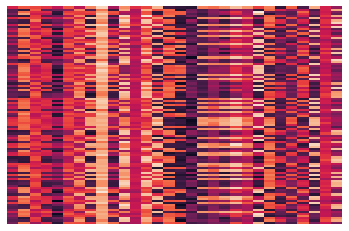
import sklearn.manifold
import sklearn.metrics as metrics
euclidean_dists = metrics.euclidean_distances(X)
mds = sklearn.manifold.MDS(n_components = 2, max_iter = 3000, eps = 1e-9, random_state = 0,
dissimilarity = "precomputed", n_jobs = 1)
fit = mds.fit(euclidean_dists)
pos = fit.embedding_
plt.axis('equal')
plt.scatter(pos[:, 0], pos[:, 1], s = 8);

Hierarchical clustering is available in sklearn, but there is a much more fully developed set of tools in the scipy package and that is the one to use.
import scipy.cluster
import scipy.cluster.hierarchy as hierarchy
import scipy.spatial.distance
# linkages = ['single','complete','average','weighted','ward']
Z = hierarchy.linkage(X, method = 'single')
R = hierarchy.dendrogram(Z)
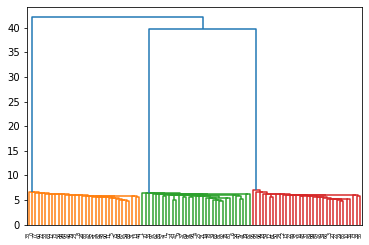
Hierarchical Clustering Real Data#
Once again we’ll use the “20 Newsgroup” data provided as example data in sklearn.
(http://scikit-learn.org/stable/datasets/twenty_newsgroups.html).
from sklearn.datasets import fetch_20newsgroups
categories = ['comp.os.ms-windows.misc', 'sci.space','rec.sport.baseball']
news_data = fetch_20newsgroups(subset = 'train', categories = categories)
from sklearn.feature_extraction.text import TfidfVectorizer
vectorizer = TfidfVectorizer(stop_words='english', min_df = 4, max_df = 0.8)
data = vectorizer.fit_transform(news_data.data).todense()
data.shape
(1781, 9409)
# metrics can be ‘braycurtis’, ‘canberra’, ‘chebyshev’, ‘cityblock’, ‘correlation’, ‘cosine’,
# ‘dice’, ‘euclidean’, ‘hamming’, ‘jaccard’, ‘kulsinski’, ‘mahalanobis’, ‘matching’,
# ‘minkowski’, ‘rogerstanimoto’, ‘russellrao’, ‘seuclidean’, ‘sokalmichener’, ‘sokalsneath’,
# ‘sqeuclidean’, ‘yule’.
Z_20ng = hierarchy.linkage(data, method = 'ward', metric = 'euclidean')
plt.figure(figsize=(14,4))
R_20ng = hierarchy.dendrogram(Z_20ng, p=4, truncate_mode = 'level', show_leaf_counts=True)

Selecting the Number of Clusters#
clusters = hierarchy.fcluster(Z_20ng, 3, criterion = 'maxclust')
print(clusters.shape)
clusters
(1781,)
array([3, 3, 3, ..., 1, 3, 1], dtype=int32)
max_clusters = 20
s = np.zeros(max_clusters+1)
for k in range(2, max_clusters+1):
clusters = hierarchy.fcluster(Z_20ng, k, criterion = 'maxclust')
s[k] = metrics.silhouette_score(np.asarray(data), clusters, metric = 'euclidean')
plt.plot(range(2, len(s)), s[2:], '.-')
plt.xlabel('Number of clusters')
plt.ylabel('Silhouette Score');
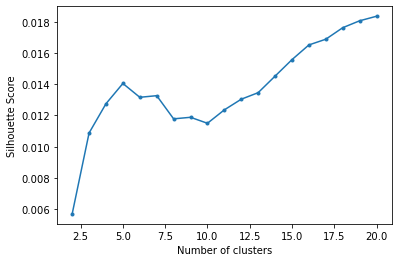
print('Top Terms Per Cluster:')
k = 5
clusters = hierarchy.fcluster(Z_20ng, k, criterion = 'maxclust')
for i in range(1,k+1):
items = np.array([item for item,clust in zip(data, clusters) if clust == i])
centroids = np.squeeze(items).mean(axis = 0)
asc_order_centroids = centroids.argsort()#[:, ::-1]
order_centroids = asc_order_centroids[::-1]
terms = vectorizer.get_feature_names_out()
print(f'Cluster {i}:')
for ind in order_centroids[:10]:
print(f' {terms[ind]}')
print('')
Top Terms Per Cluster:
Cluster 1:
space
nasa
edu
henry
gov
alaska
access
com
moon
digex
Cluster 2:
ax
max
b8f
g9v
a86
145
1d9
pl
2di
0t
Cluster 3:
edu
com
year
baseball
article
writes
cs
team
game
university
Cluster 4:
risc
instruction
ghhwang
csie
set
nctu
cisc
tw
reduced
mq
Cluster 5:
windows
edu
file
dos
com
files
card
drivers
driver
use
